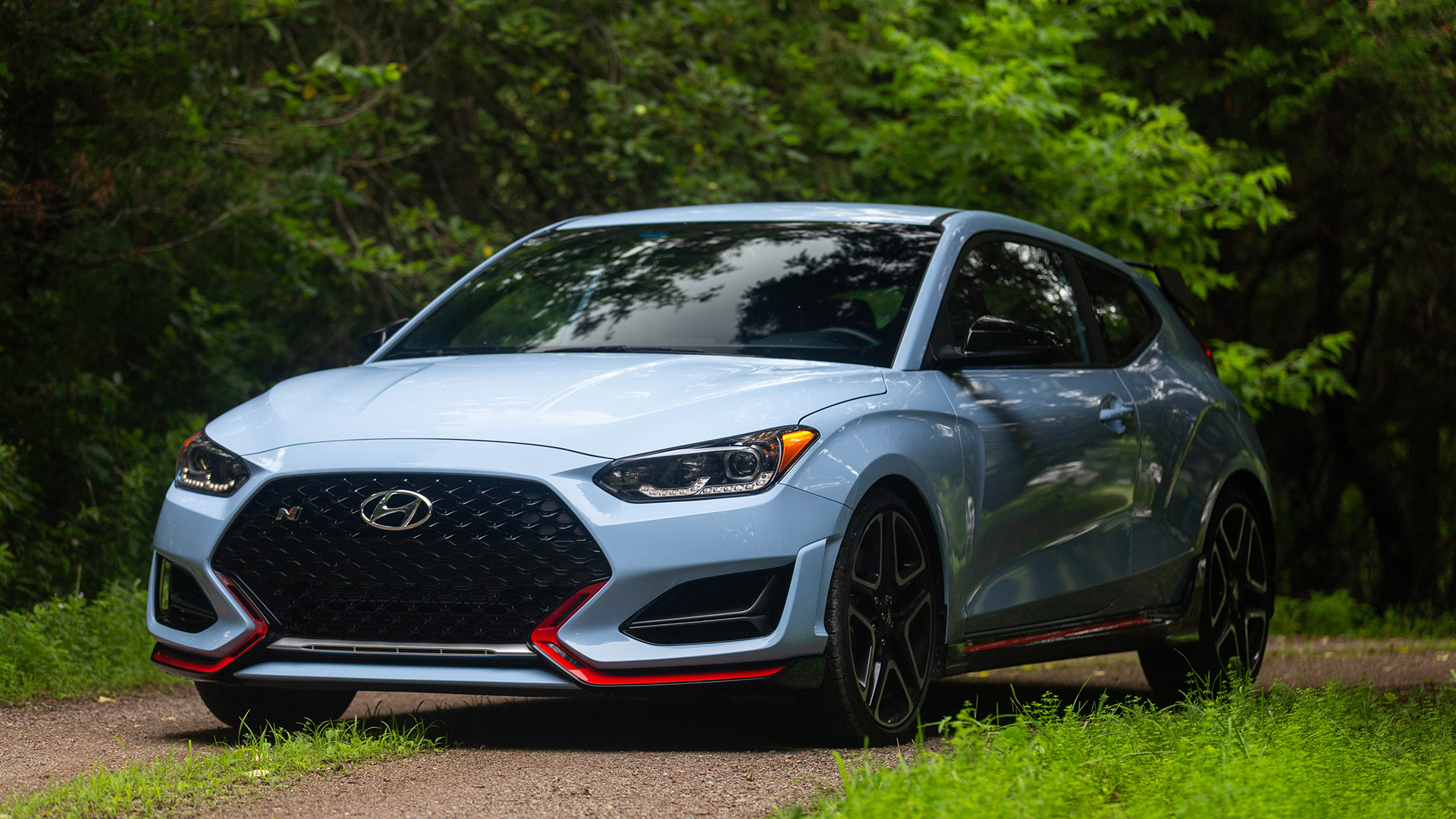There’s something about getting into the driver’s seat of a Performance Blue 2021 Hyundai Veloster N that makes you feel silly. And I don’t mean this in a bad way. Student loans, taxes, mortgages, 401(k)s—boring! Boring shit. It can sometimes feel like we’re all just here to do life admin until we die. If this is your reality, which I suspect is true for many of us, bright spots of silliness are most welcome.
You feel silly in the Veloster N simply because it’s a ridiculous vehicle. Electric blue with seat belts to match, it has red trim all over it, a goofy-ass wing, and three doors. It’s burbly on startup and riotously quick to drive. Your everyday responsibilities don’t matter here. Getting seat time in it is like stepping into Neverland. You don’t have to grow up if you don’t want to.

2021 Hyundai Veloster N: By the Numbers
- Base price (as tested): $19,905 ($34,755)
- Powertrain: 2.0-liter turbocharged 4-cylinder | 8-speed dual-clutch | front-wheel drive
- Horsepower: 275 @ 6,000 rpm
- Torque: 260 lb-ft @ 1,450 to 4,500 rpm
- Curb weight: 3,247 pounds
- Seating capacity: 4
- Cargo volume: 19.9 cubic feet
- EPA fuel economy: 20 mpg city | 27 highway | 22 combined
- Quick take: Wanna have fun? Wanna have fun ALL THE TIME EVEN IF YOU AREN’T IN THE MOOD? Drive a Veloster N.
N All of the Things
The Hyundai Veloster—a sporty, three-door compact hatch—itself isn’t new. What was new was that Hyundai N-ified it in 2019 and unleashed it into the North American market, where it was sorely needed. Affordable and properly hot hatchbacks have dwindled to truly tragic numbers, so much of our collective hope hangs on this little car.
To that point, this is also the only Veloster option we have anymore. As I was test driving this car and working on this review, I got the news that the base, non-N Veloster had been canceled amid dwindling demand for smaller cars. Much like how the only Volkswagen Golf available in North America soon will be the GTI and Golf R, it seems buyers here only want smaller cars if they’re fast. So be it, then.
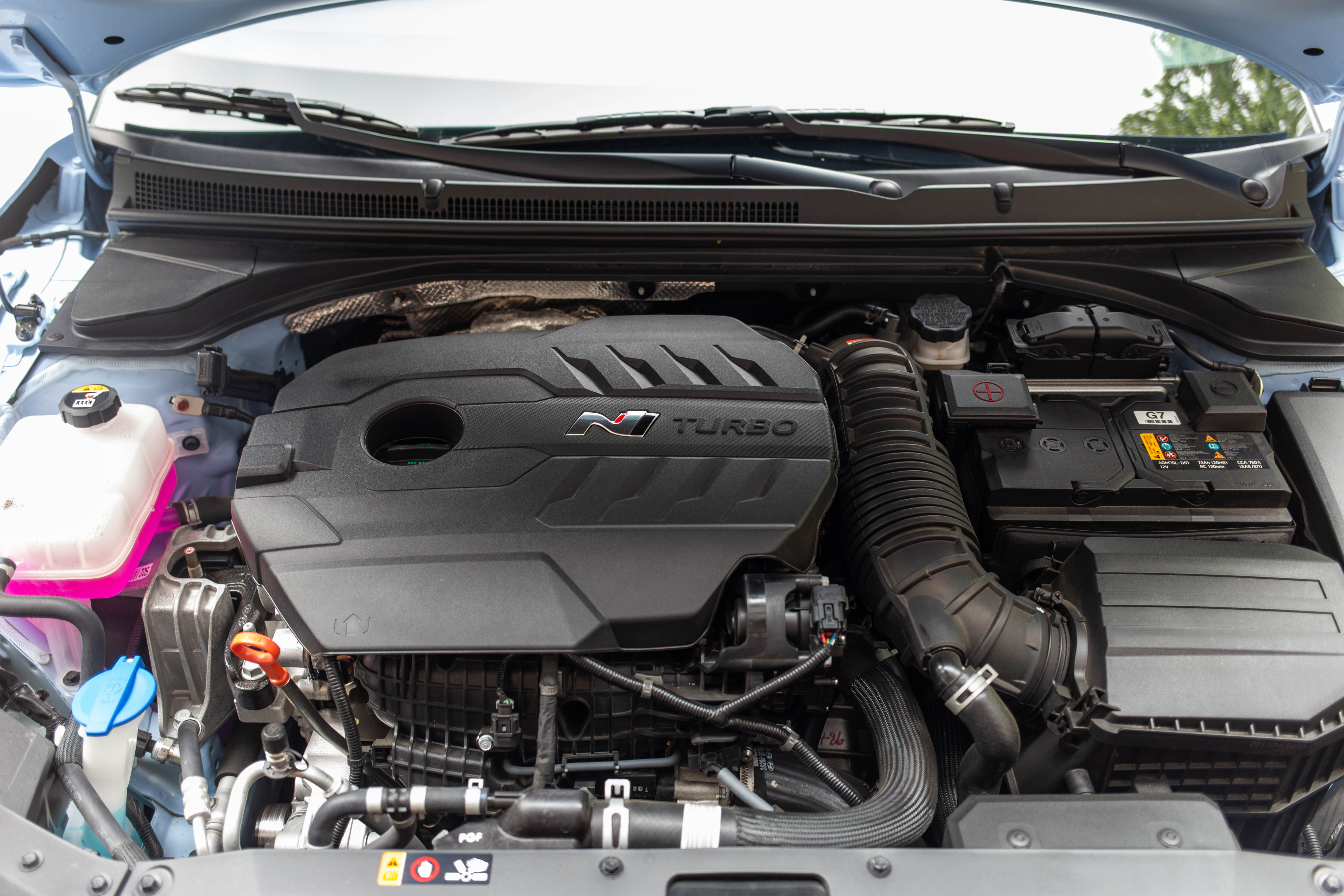



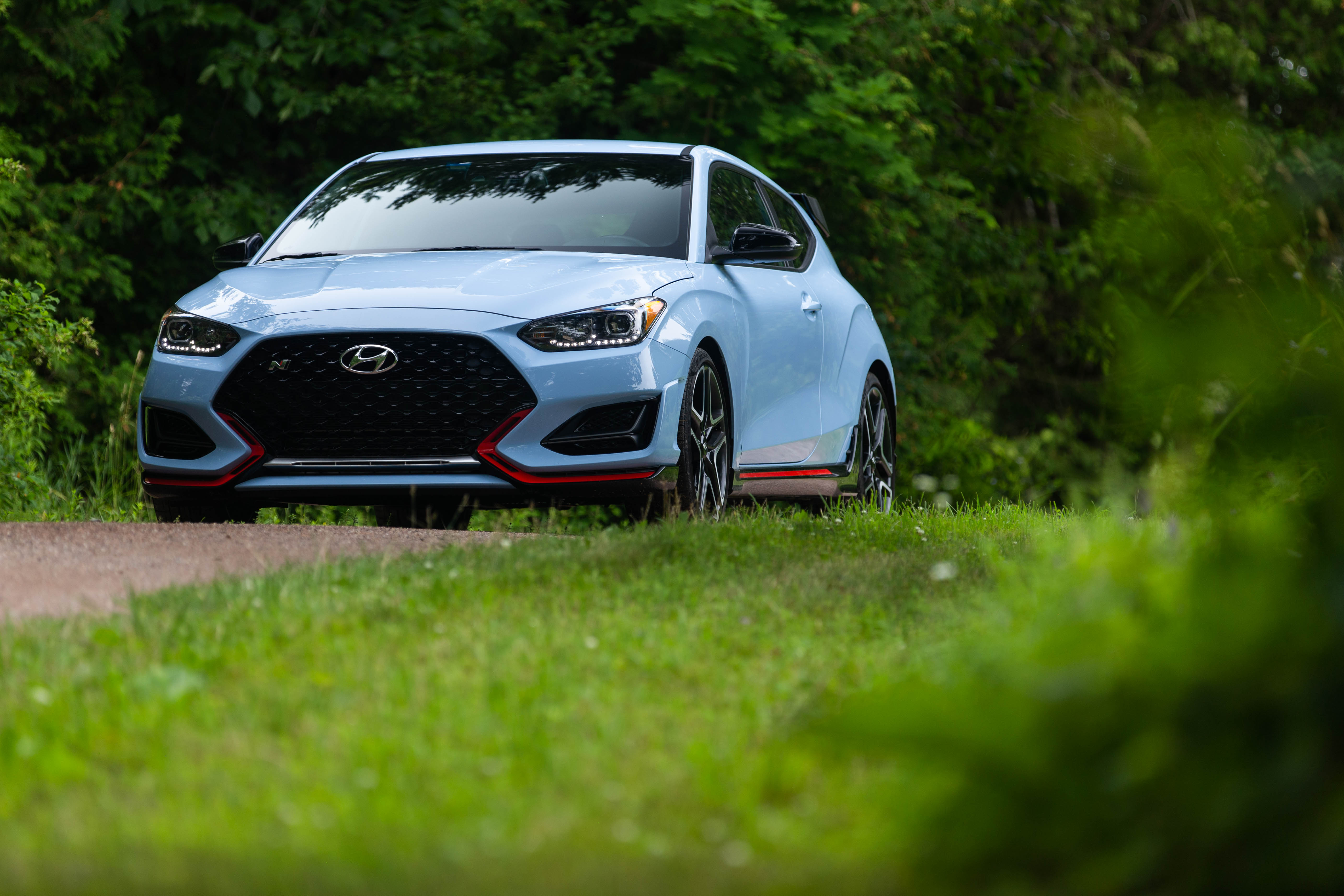
The good news is Hyundai didn’t mess with the Veloster N. It always took pains to get this car right. It hired Albert Biermann—the ex-vice president of engineering at BMW M—to head up its own R&D division. This is what we got as a result and more Hyundai Ns are coming, too.
From the angry hornet’s nest of a turbocharged 2.0-liter engine comes a claimed 275 horsepower and 260 pound-feet of torque that’s all sent to the front wheels. It used to be that the Veloster N was offered exclusively with a six-speed manual transmission, but 2020 model-year changes saw to the inclusion of an optional eight-speed dual-clutch transmission with paddles, which is how the test car came outfitted. Compared to the 3,106-pound manual car, the DCT adds 141 pounds of overall weight.
From the outside, the Veloster N sports bigger front air ducts for improved brake cooling, 19-inch wheels, a rear diffuser, and a large rear wing. Everything is lined in attractive red trim that might be taken as garish to some but scored look points with me. Chiefly, it’s not a particularly elegant-looking vehicle, but honestly, who cares? You don’t get this car for its looks.
Inside, the Veloster N very clearly wears the “economy car that’s been turned into a performance car” schtick, which is great. Everything is laid out logically. Hyundai’s designers didn’t try and reinvent the wheel here so you can just get in drive without first having to learn it.

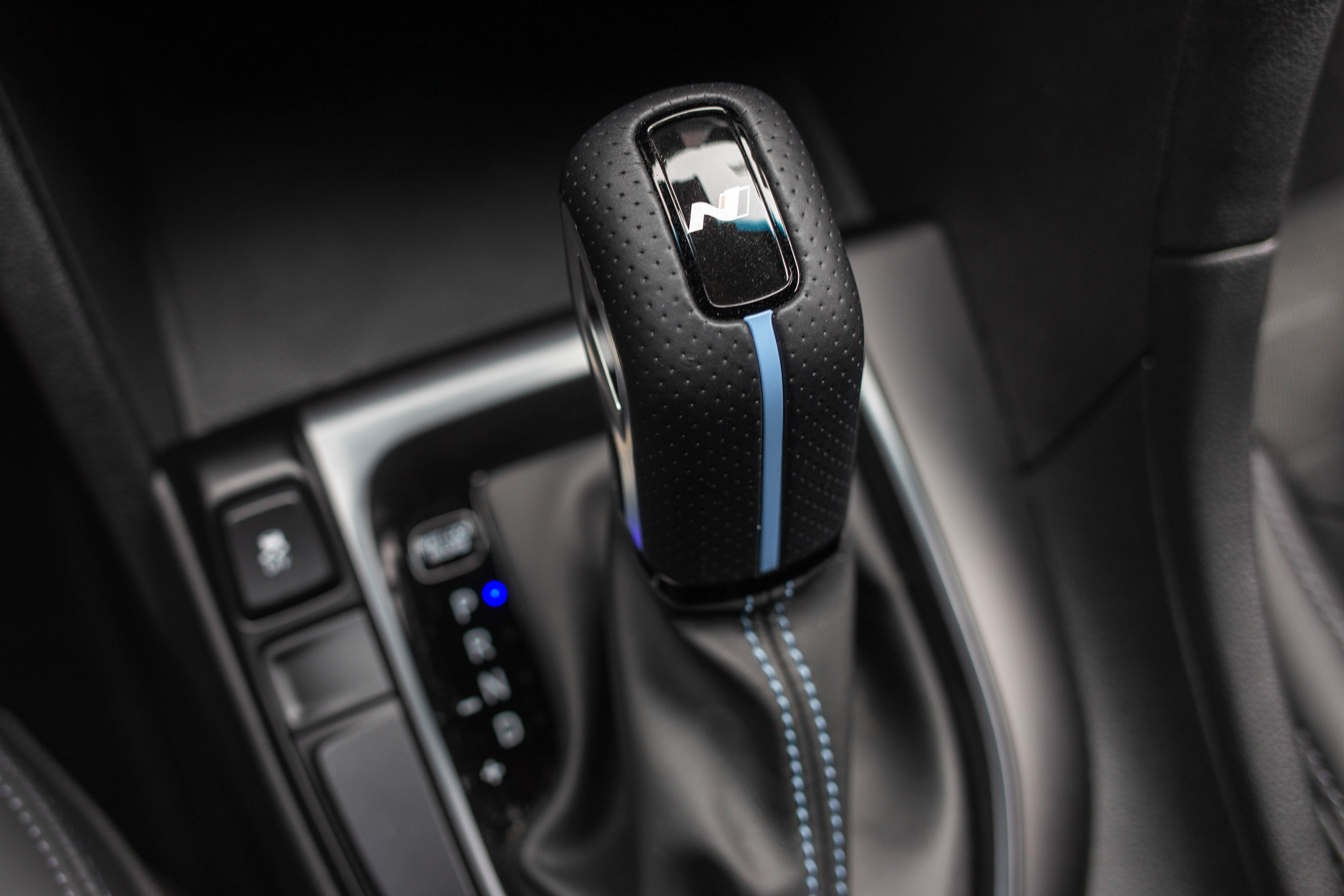


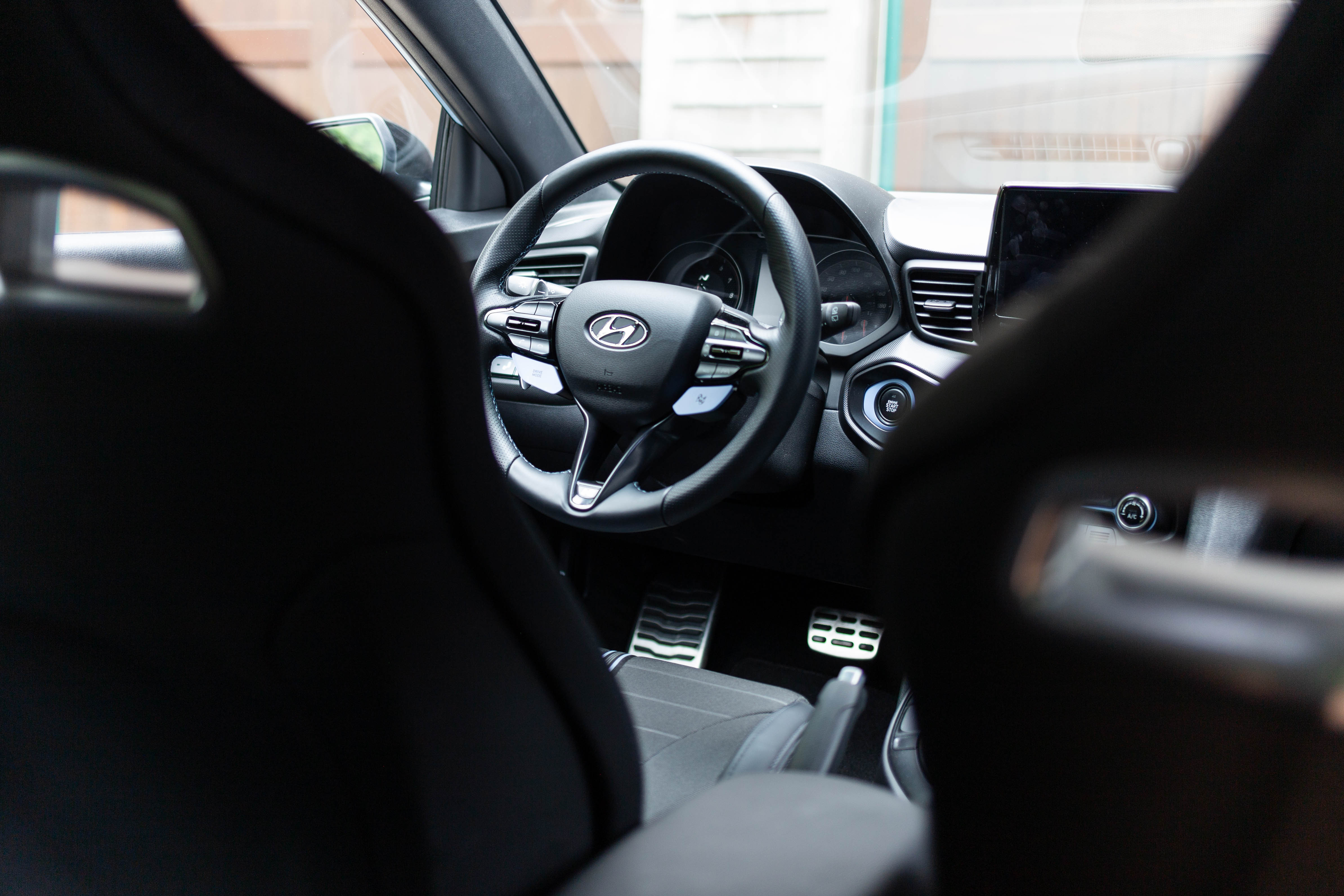
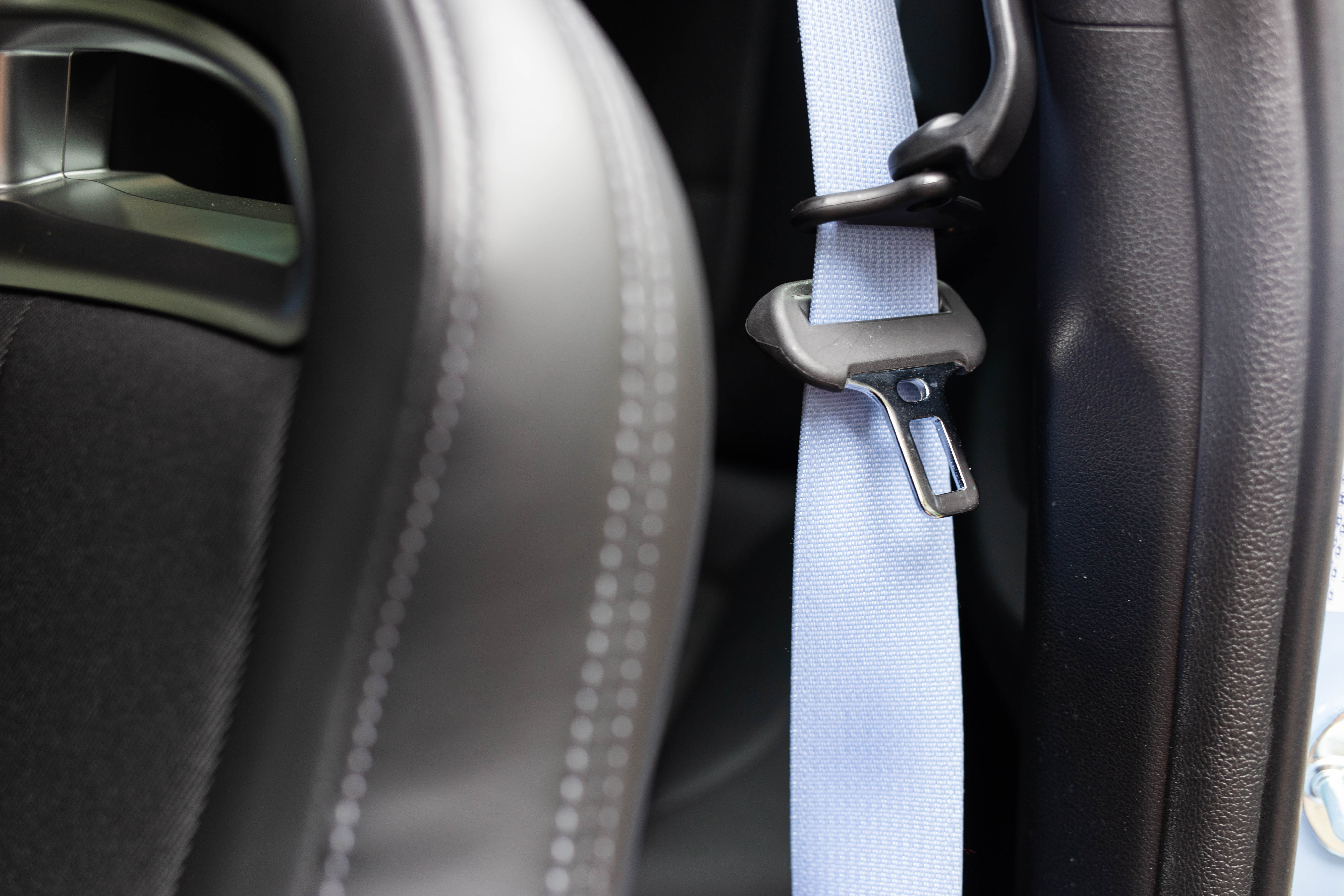


Electric blue contrast stitching lines the cloth seats and the steering wheel features two blue buttons: one to select drive modes with and the other, decorated with a picture of a checkered flag, engages N Grin Shift mode—or NGS, and no, I’m not joking—which increases the car’s torque briefly by seven percent and sharpens up the transmission response for 20 seconds.
Only the passenger side features the rear door, so to sit behind the driver you have to slide over some cupholders and a cubby that Hyundai placed in the middle of the rear bench seat. Legroom is decent, but you’ll have to duck your head getting in and out of that back seat because of the sloping roof.
But the best part of the interior? Those blue seat belts.
Hyperactive Whiz-Bang
My brother recently got a mini Aussie puppy. His name is Mochi. Mochi has so much goddamn energy it’s sometimes unbelievable. When Mochi is “on” (as he oftentimes is) he’s breathtakingly excitable—a Tasmanian Devil-whirl of prancing paws—and interprets literally any kind of interaction or stimulation as an invitation to play. (Dog tax below.)
The Veloster N is just like Mochi.
By and large, I find many cars today don’t have much of a personality. They’ll go fast, they’ll go slow, and it doesn’t seem like they care either way. This is not the case with this Hyundai. It is always raring to go. Always. The lightest touch on the gas pedal results in a downshift even if you don’t want it! The Veloster N relishes in going fast—constantly hyping to go 20 mph over any speed limit—and feels tangibly bored and disappointed with you if you drive it too slowly. For those trying to avoid getting a ticket, it’s dangerous stuff.
Obviously, I missed the six-speed manual. But I also won’t deny the dual-clutch is wonderful, snapping off shifts like a bored high-schooler cracking gum in chem class. It’s smooth around town and in traffic and keeps up with you under more demanding driving. Per my own observations, first gear topped out at 35 mph, second gear at 57 mph, and third gear at 80 mph. I know this doesn’t sound super atypical, but in a car with a buzzy 275 hp, the gears felt as tall as trees. I could really wind out the engine before I had to shift, which lent to an even greater feeling of urgency to the Veloster N. It’s one of the rare cars where you can’t go wrong with either gearbox option. Both are fun, and both suit the character of this machine.
The engine isn’t much to listen to but, man, does it love a good poking. Revvy as hell, it punches up the rev range with hilarious alacrity. The Veloster N is a case study in quick cars not necessarily being fast cars. Its straight-line acceleration is decent but its fleet-footedness truly shines when being nosed around a tighter curved road.
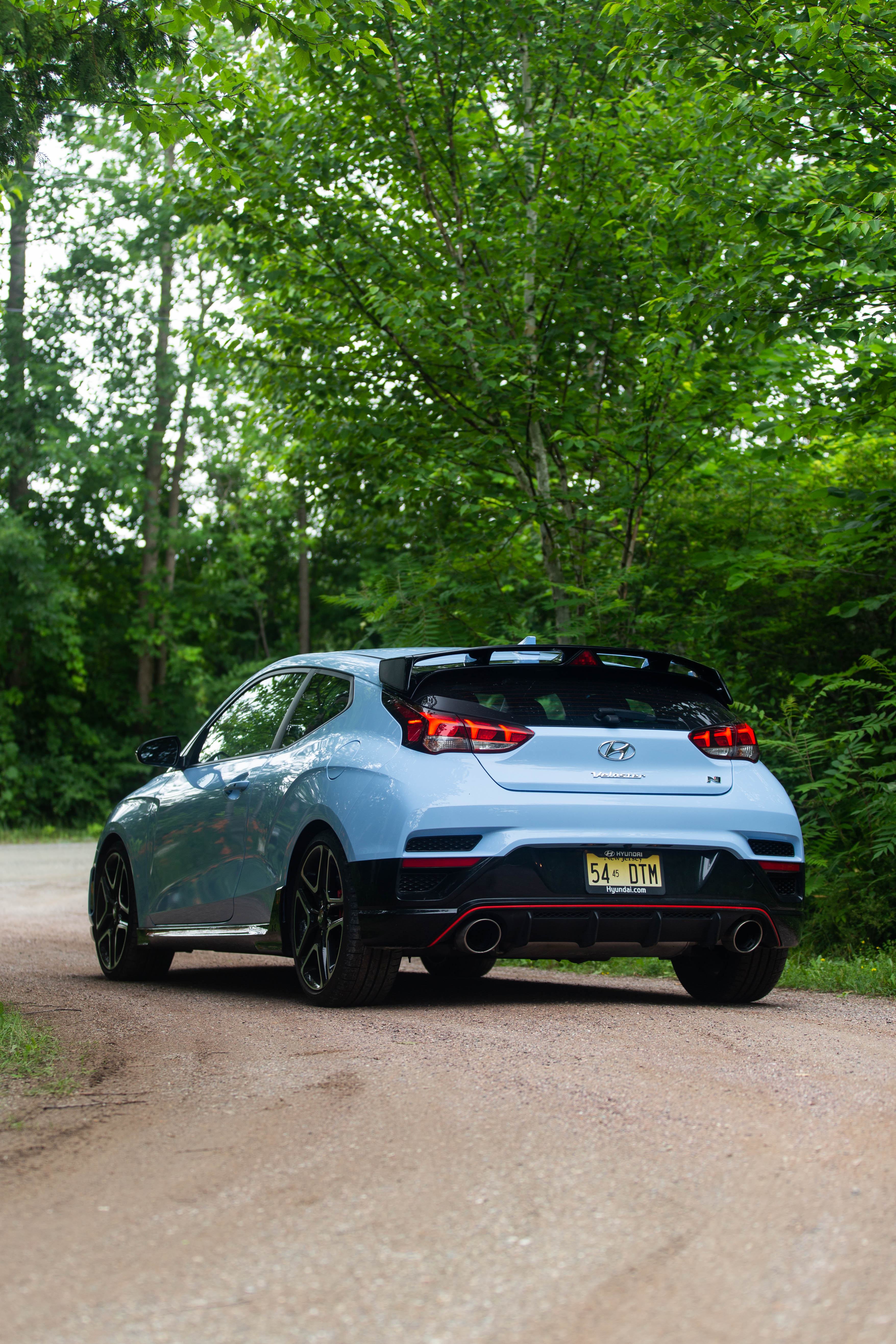
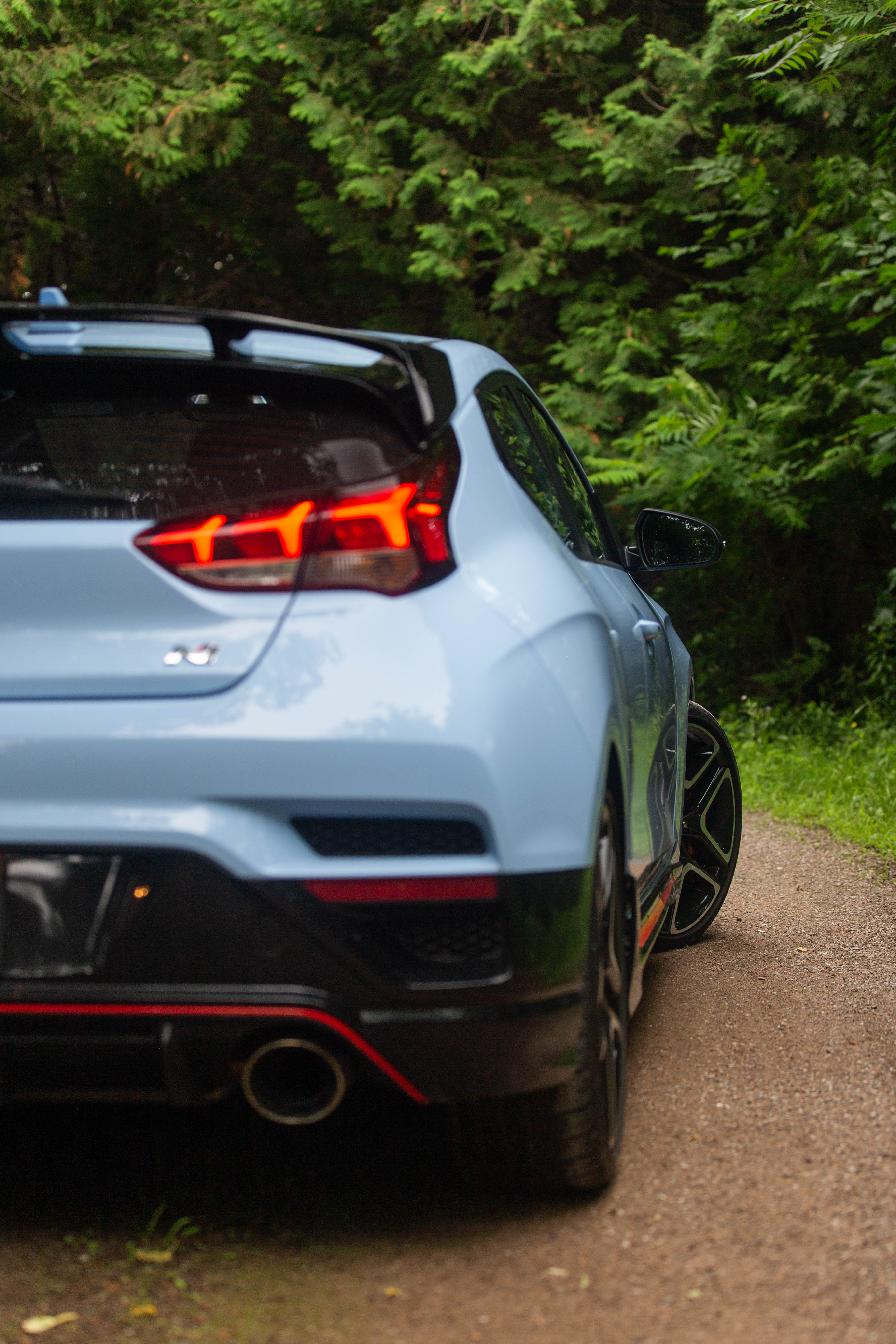



Even though the Hyundai is front-wheel-drive, it sure doesn’t feel like it in the majority of everyday driving. With how much grip it carries in the corners and how planted it always feels, you’d think it was all-wheel-drive. Paired with its precise steering, it dares you to chuck it into turns—like a flea riding on the tip of a bullwhip—and you can’t help but happily oblige.
As you’d expect of a performance car, the Veloster N rides on the harder side. Following what Peter Holderith recently found in the Kona N, it’s not so much bone-shaking suspension as much as it’s just bumpy. Toggling between the car’s drive-mode settings doesn’t change squat. Sorry.
Highs and Lows
So, yeah. The Hyundai Veloster N is fun. That is its most powerful, most attractive trait.
It’s also quirky and weird because it has three doors. Initially, I thought I wouldn’t be able to access the driver-side back seat, but the driver-side door is cut a bit longer than the passenger-side front door and allowed me to easily access whatever cargo I had there. In fact, cabin space was pretty good, especially if you don’t have rear passengers and can fold the rear seats down. By virtue of being a hatchback, my partner and I were able to fit a shocking amount of stuff in the Veloster N.



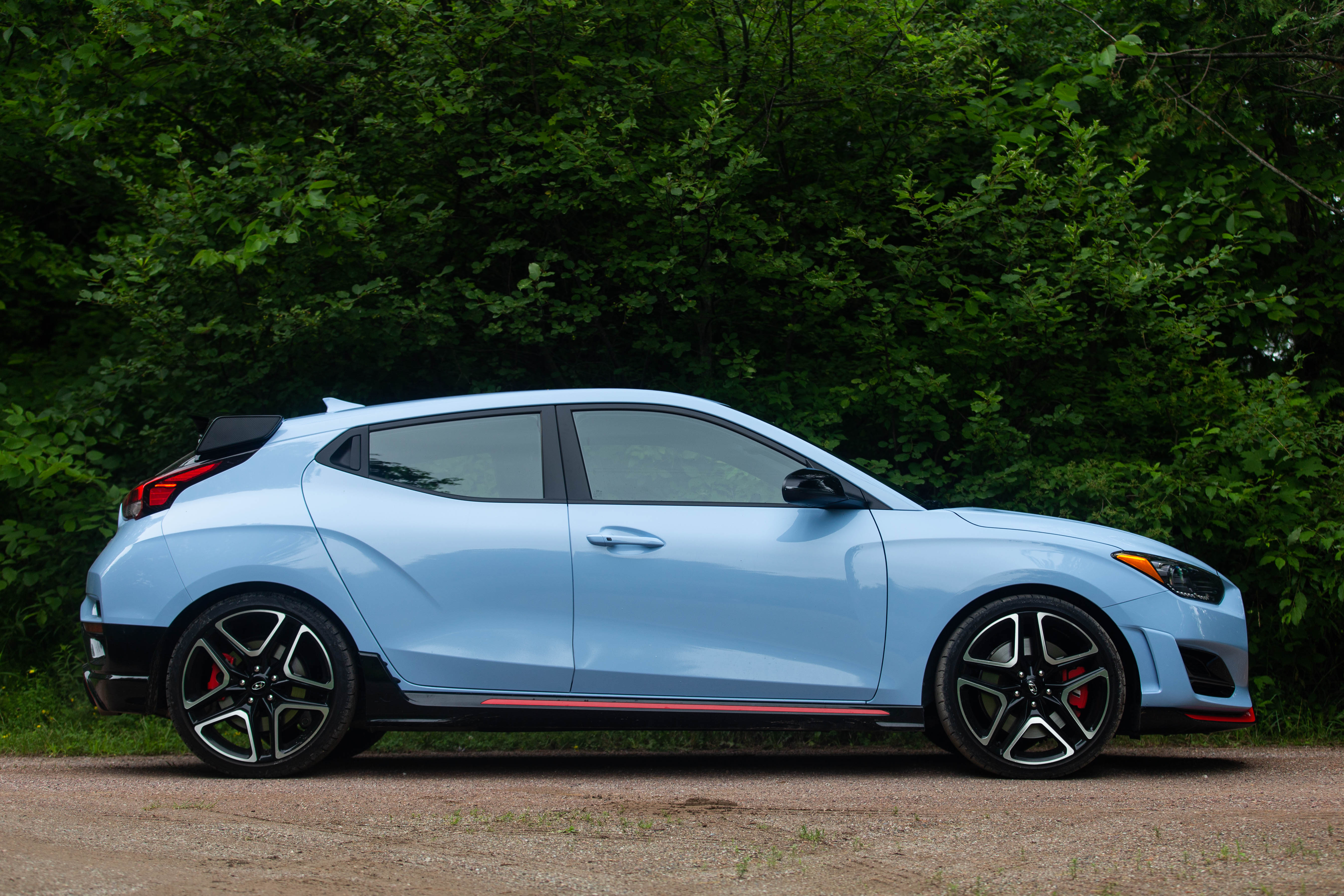
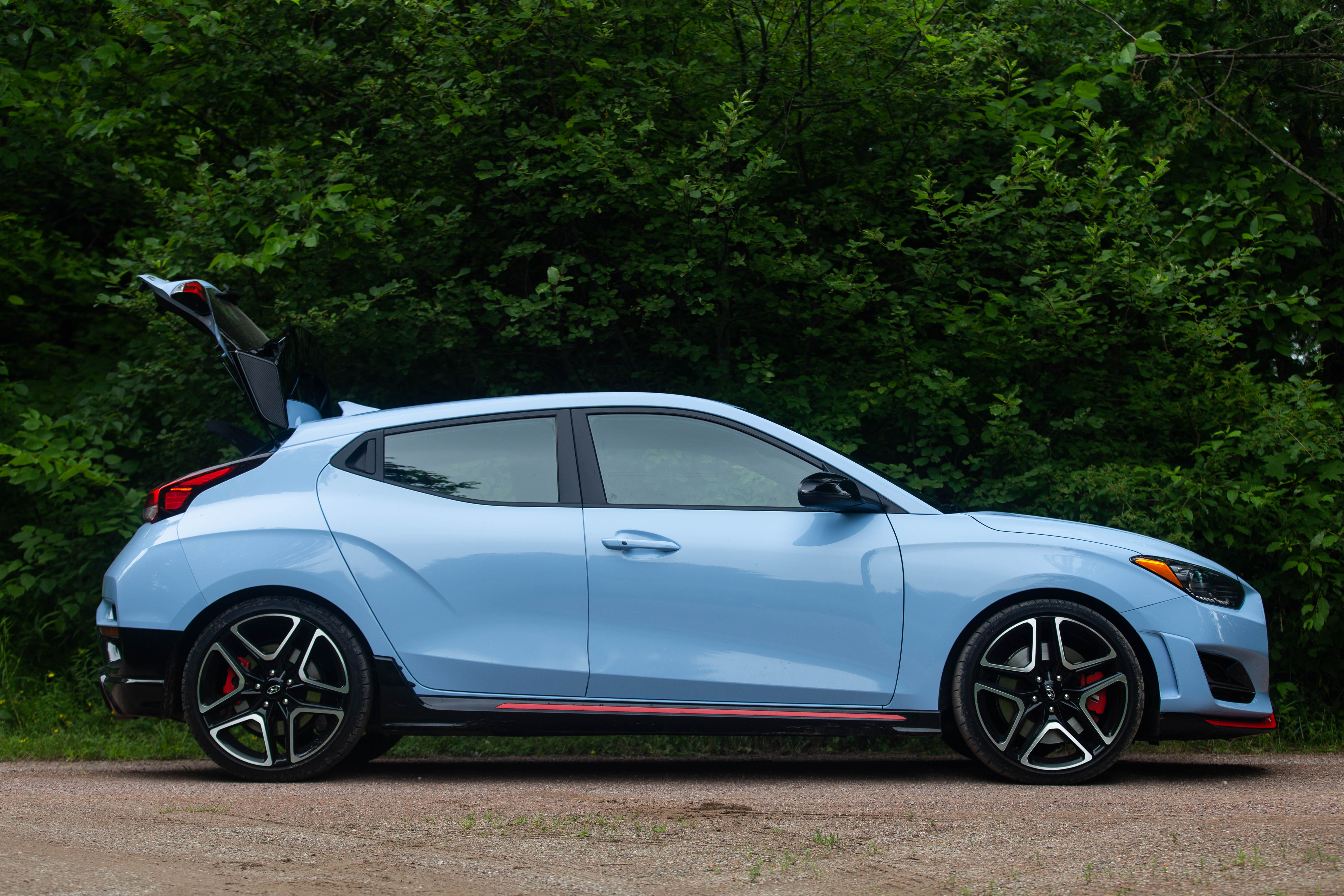

The car also returned good gas mileage. I put on over 900 miles over the course of my 10-day test and averaged 29.7 mpg. Driving happened mostly on highways and in Eco mode, but there was also some around town and city driving with traffic. Just keep an eye on your fuel gauge. With a 13.2 gallon tank, you’ll need to fill up more frequently than you think.
The Veloster N is not without its compromises, however. After about 45 minutes of driving, my butt started to hurt. There’s very little support in the seats and I spent the next five hours of my six-hour drive dancing on different parts of my ass in a desperate search for comfort. The problem doesn’t go away after you duck your head and climb into the back seats, either. Once there, things are additionally a bit claustrophobic thanks to the high beltlines.
Because the Veloster N is so low to the ground (usually a good thing), it also means every oncoming and following truck and SUV’s headlights shine directly into your eyes even without them switching on their high beams. This isn’t really the car’s fault, though. Everything else on our roads is just massive.
What could have used some improvement is the size of the rear window. Due to how aggressively it’s sloped, it offered very little rearward visibility. I couldn’t fully see cars following even at two car lengths.



There also does not appear to be adaptive cruise control, both on the test car or available as an option in general. There is regular cruise control, though. You just can’t set a follow distance and have the Veloster N brake while “watching” the car in front.
Finally, it’s pretty loud in the cabin. A combination of tire noise, wind noise, and engine noise all compete for the loudest drone. You’ll need to turn the radio up higher, speak to your passenger a bit louder. It’s real good for masking you muttering to yourself under your breath, though.
No Options, One Competitor
Refreshingly, the 2021 Veloster N doesn’t come with a laundry list of options. The car is far too impatient to get back on the road to get bogged down with you picking out dumb, trivial crap like what kind of seats you’d like, your ass be damned. Your options are four exterior colors (white, red, black, blue; go with the blue) and either the manual or dual-clutch transmission. That is it.
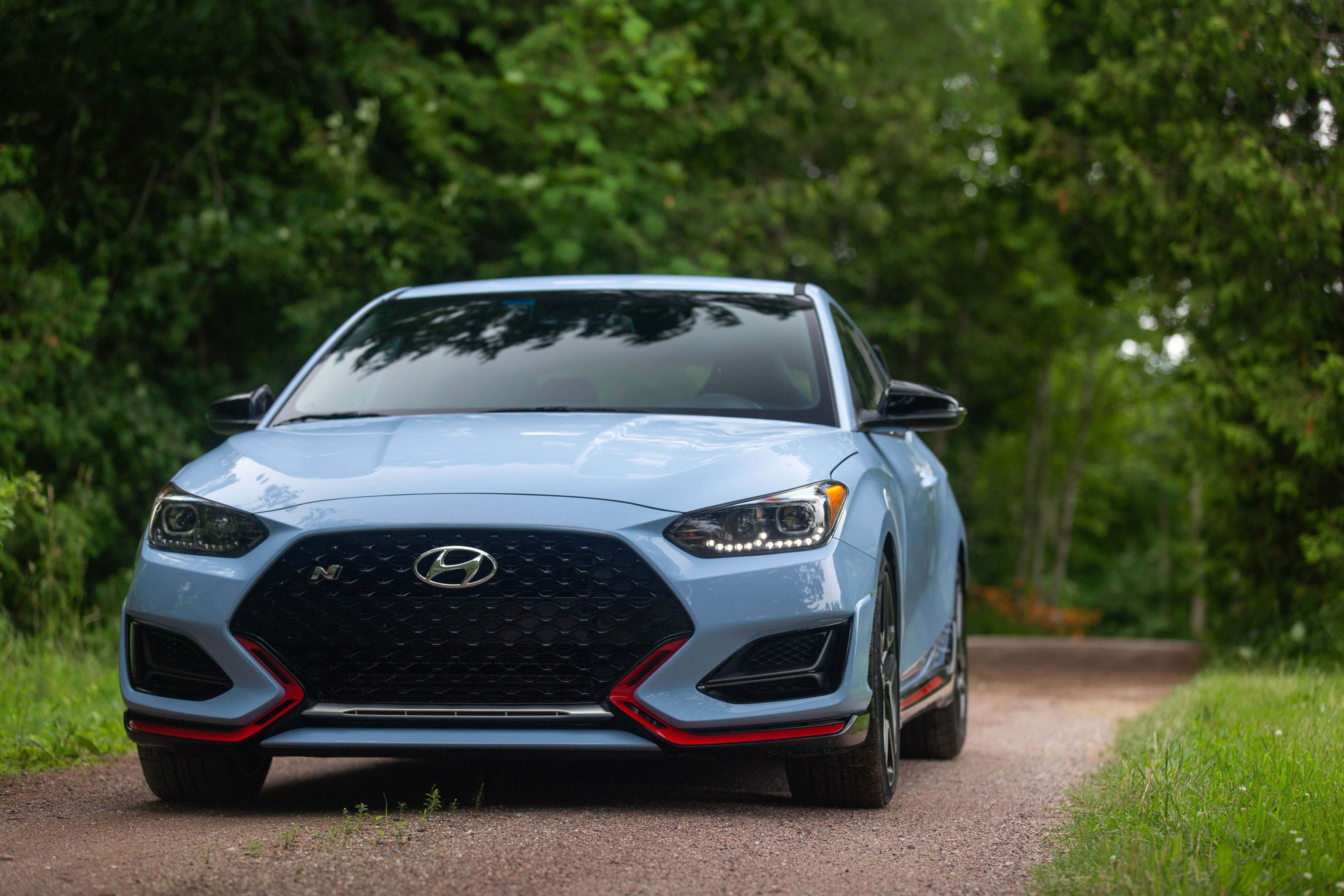




The base price of the test car came to $33,750 thanks to the DCT; final MSRP came to $34,755 after the $1,005 destination fee.
The Veloster N can count the Honda Civic Type R and Volkswagen Golf R among its most direct competitors, though I hesitate to even include the VW because it’s over $10,000 more expensive and considerably more premium in general. And though the new Mazda 3 Turbo is fun, it’s no Mazdaspeed3 successor and it’s not a rowdy hot hatch on the same level as this car.
So the Civic Type R it is. I have a review of that coming soon and I don’t want to spoil it here, but the Veloster N is hotter. It’s more raucous in every way.
I won’t sugarcoat it: There are barely any hot hatches left in the North American market. I can count how many there are on the fingers of one hand. And rather than building something with a wider appeal, as Mazda did with the turbocharged 3, Hyundai leaned the hell into hot with this hatch.
It’s as polarizing as it is uncompromising. If you’re on the fence about how hot you want to get, the Veloster N is probably too hot for you.

Anyone who buys this car does so on purpose. There is no room for mixup at the dealer because as soon as you get behind the wheel, the Veloster N introduces itself forcefully and with immediacy. There is no warm-up period. It lets you know what it’s about right off the bat.
I respect that so much. After just five minutes, anyone with a functioning nervous system will know whether they like the car or not. Me? I loved every minute spent with it. The Hyundai Veloster N embodies youthful energy and zest. I had no choice but to keep up with it.
Got a tip? Hit me up at kristen@thedrive.com.
